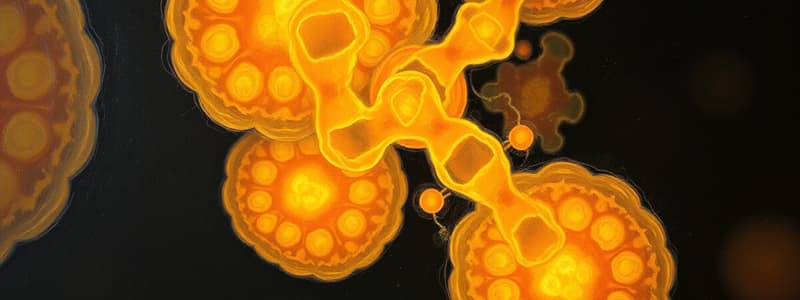Podcast
Questions and Answers
What is the primary function of the Golgi apparatus in eukaryotic cells?
What is the primary function of the Golgi apparatus in eukaryotic cells?
- Energy production
- Synthesis of DNA
- Modification, packaging, and transport of substances (correct)
- Cell division
Which face of the Golgi apparatus is described as the 'maturing face'?
Which face of the Golgi apparatus is described as the 'maturing face'?
- Trans face (correct)
- Convex face
- Cis face
- Concave face
What are the flattened membrane-bound sacs in the Golgi apparatus called?
What are the flattened membrane-bound sacs in the Golgi apparatus called?
- Cisternae (correct)
- Vesicles
- Lysosomes
- Tubules
What type of substances are modified by the Golgi apparatus to form lipoproteins?
What type of substances are modified by the Golgi apparatus to form lipoproteins?
Which process in plant cells involves the Golgi apparatus forming vesicles at the equator of the cell?
Which process in plant cells involves the Golgi apparatus forming vesicles at the equator of the cell?
Flashcards are hidden until you start studying
Study Notes
Discovery and Structure
- Discovered by Camillo Golgi in 1898.
- Present in all eukaryotic cells and characterized as a single membrane-bound organelle.
- Composed of stacks of flattened membrane-bound sacs known as cisternae.
- Features a complex system of interconnected tubules.
Functional Faces
- Two distinct faces:
- Cis Face: Convex shape; serves as the forming face where substances enter.
- Trans Face: Concave shape; acts as the maturing face where substances exit.
Packaging and Transport
- Cisternae break off from the Trans face to form vesicles, which are released into the cytoplasm.
- Often referred to as the "Post Office of the Cell" due to its role in receiving, modifying, packaging substances into vesicles, and transporting them.
- Essential for cell secretion; substances produced by ribosomes enter the endoplasmic reticulum and Golgi apparatus for modification and packaging.
Examples of Function
- Granules containing digestive enzymes are formed by the pancreas through the Golgi apparatus.
- Proteins undergo modification within the Golgi, such as:
- Addition of lipids to create lipoproteins.
- Addition of carbohydrates to form glycoproteins.
Organelle Production
- Golgi apparatus produces various organelles such as peroxisomes, lysosomes, and glyoxysomes.
Role in Plant Cells
- In plant cells, the Golgi complex facilitates the formation of vesicles during cytokinesis.
- Vesicles arrange at the cell equator to create the Phragmoplast, which ultimately leads to the formation of the cell wall.
Studying That Suits You
Use AI to generate personalized quizzes and flashcards to suit your learning preferences.



